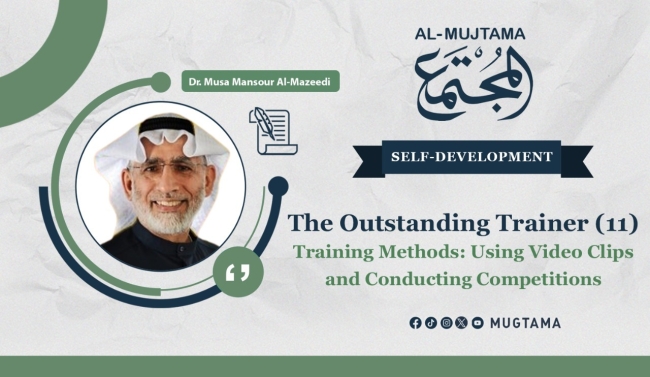In this article, we continue presenting captivating training methods that grab the trainees' attention:
- Video Clips Presentation:
Presenting video clips is one of the most effective ways to solidify principles in the trainees' minds, as well as an important method to break routine and eliminate boredom during training sessions.
However, trainers should be aware that some video clips are copyrighted and come with the training product. There are also public administrative and leadership clips available on platforms like YouTube, along with outstanding real-life films produced by Hollywood, containing excellent clips. Additionally, trainers can use videos they have produced themselves.
The trainer should ensure that each video clip does not exceed 10 minutes, as long clips may lead to boredom.
Example (1): In a time management workshop held at Kuwait Oil Company, a 4-minute clip from the film Cast Away starring Tom Hanks was shown. The clip effectively demonstrated the importance of time and how to manage it.
Using Video Clips: One of the Best Ways to Reinforce Principles and Break Routine
Example (2): In another workshop at the Leaders Academy of the Teachers Association, titled Building a Successful Team, a 5-minute clip from the movie Apollo 13, also featuring Tom Hanks, was presented. It illustrated how to manage a successful team assigned to launch a space capsule.
Example (3): During a workshop at Al-Amiri Hospital for a group of doctors on charismatic personality traits, a one-minute video clip produced by the trainer was shown, showcasing the characteristics of a charismatic personality.
Example (4): In another workshop at the Petroleum Training Center titled The Benefits of Delegation, a 6-minute video clip from YouTube was shown, explaining how to delegate tasks effectively.
Example (5): In a workshop at Investment House Company titled Mastering the Art of Problem-Solving, three 10-minute video clips from the world-renowned trainer Nido Qubein were shown. These clips, which came as part of the training package from the U.S., were copyrighted.
The trainer should aim to energize his sessions by presenting relevant and expressive video clips that align with the session's topic.
- Conducting Training Competitions:
The trainer must know that testing the trainees' level of knowledge can be done through various methods. One of the most effective ways is by holding competitions among the trainees. Teams are formed, with a leader and a scorekeeper for each team.
The trainer begins by imposing rules for the competition and explaining the scoring method. Here are some of the rules that can be applied:
- The team leader or their designated representative is the spokesperson.
- A scorekeeper records the points for each correct answer.
- Each team is given up to 30 seconds (or less) to answer each question.
- If a team fails to answer, the question is passed to the next team.
- If a team answers a question without authorization, a point is deducted from their score.
Assessing Trainees' Knowledge Through Competitions
It is recommended that each competition lasts between 15 to 20 minutes, with 20 to 25 questions. The ideal number of teams ranges between 4 and 6.
Example (1):
In a training course held for the Kuwait Petroleum Corporation titled Golden Keys to Customer Service, a competition was organized featuring several famous global personalities known for leading companies distinguished in customer service.
The trainees were divided into teams, the competition rules were explained, and photos of these famous personalities were displayed without revealing their names. Each team was tasked with identifying the individuals in the photos. The process continued team by team, and at the end, prizes were awarded to the winning team.
In this type of competition, the trainer can present photos of personalities renowned for exceptional public speaking, workaholism, innovation, breaking records, training, or achievements in various technical or human sciences, and ask trainees to identify them.
The most enjoyable part of these competitions is when a team member speaks without being authorized, resulting in a point deduction according to the rules. The trainees usually start laughing and plead for forgiveness from the trainer, but the trainer insists: "No favors, no compromises, no exceptions—we must learn discipline and adherence to competition rules." This teaches trainees the importance of commitment and discipline.
Example (2):
In a training course held for the Council of Ministers titled How to Deal with Difficult Personalities, a competition was conducted on the best ways to handle critical situations when dealing with challenging individuals. For each question, four possible responses were provided on how to manage the critical situation, and each team was asked to choose the best answer simultaneously.
The best part of this competition is when some trainees object to certain answers. However, upon seeing that most teams agree on the correct answer, they reconsider their own response!
Example (3):
In a training course at Kuwait Oil Company titled The 70-Minute Hour, a time management square competition was held, focusing on prioritization.
In this competition, a scenario is presented, and trainees are asked to choose from four possible answers: the emergency square, the planning square, the interruption square, or the trivialities square.
This competition teaches trainees how to allocate their time based on the elements of importance and urgency. They learn to prioritize situations requiring both importance and urgency (emergencies), followed by situations that require importance without urgency (planning), then situations requiring urgency but not importance (interruptions), and finally situations that require neither importance nor urgency (trivialities).
In the next article, we will continue exploring other types of competitions that instill managerial concepts in trainees’ minds, far from theoretical philosophies and empty talk.
-------------------------------------------------------------


